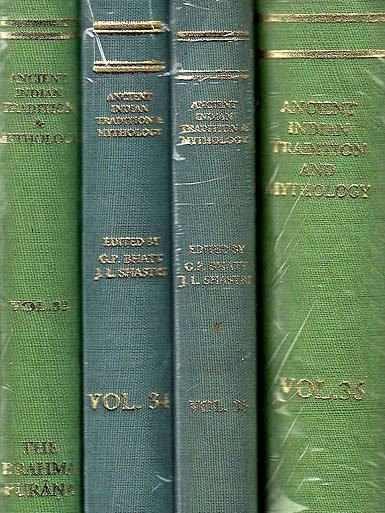The Gautami Mahatmya
by G. P. Bhatt | 1955 | 127,137 words
This is the English translation of the Gautami-Mahatmya, which forms the fourth part of the Brahma-purana. The Gautamimahatmya narrates the legends and merits of the various holy places (tirthas) situated around the bank of the Godavari river in 105 chapters. It can be seen as distinct work by itself, and was declared as a “highly meritorious puran...
Brahmā said:
1. The holy centre well known as Cakratīrtha destroys sins by mere remembrance. I shall recount its greatness. Listen attentively, O Nārada.
2. Seven sages with Vasiṣṭha as their leader are well-known, O sage. They resorted to the banks of Gautamī and began to perform Satrayajña.
3. When a terrible obstacle was started by the Rākṣasas there, the sages approached me and intimated to me the activities of the demons.
4-5. Then, O Nārada, I created the form of a young maiden, by means of Māyā. Saying, “By the mere sight of this (woman) the Rākṣasas shall perish”, I gave that young maiden to the sages, O sage. At my instance, the sages went back taking Māyā with them.
6-8. That Māyā exists in physical form even today well known by the name of Muktakeśī (one whose tresses are loose). She is Ajā (unborn) and Ekā (single) and has black and red forms. She can assume any form as she pleases. She inflicts delusion in all the three world. On account of her power the excellent sages had peace of mind. They went to Gautamī, the excellent river, and got themselves initiated for the Yajñas once again. Again the Rākṣasas came there to destroy that sacrifice.
9. On seeing Māyā near the sacrificial ground the leading Rākṣasas began to dance, sing, laugh and cry.
10-11. The great Māyā of Maheśvara was excessively proud on account of her power. Among them there was the lord of Daityas named Śambara. He was valorous and he devoured the young woman of the form of Māyā, O Nārada. It was extremely surprising to those persons who had seen the power of Māyā.
12. When the sacrifice was being destroyed they sought refuge in Viṣṇu. Then Viṣṇu gave his discus for the protection of sages.
13. That discus chopped off the Daityas, Danujas and Rākṣasas in the battle. The leading Rākṣasas died on account of their fear of it.
14. That great Satra was completed by the sages. Sudarśana, the discus of Viṣṇu, was washed by the waters of Gaṅgā.
15-16. Thenceforth that holy centre is cited as Cakratīrtha. By taking holy bath and offering charitable gifts there one shall obtain the fruit of Satra sacrifice.
There are five hundred holy centres that dispel sins. Taking holy dip and the offering of charitable gifts in each of them yields liberation.
